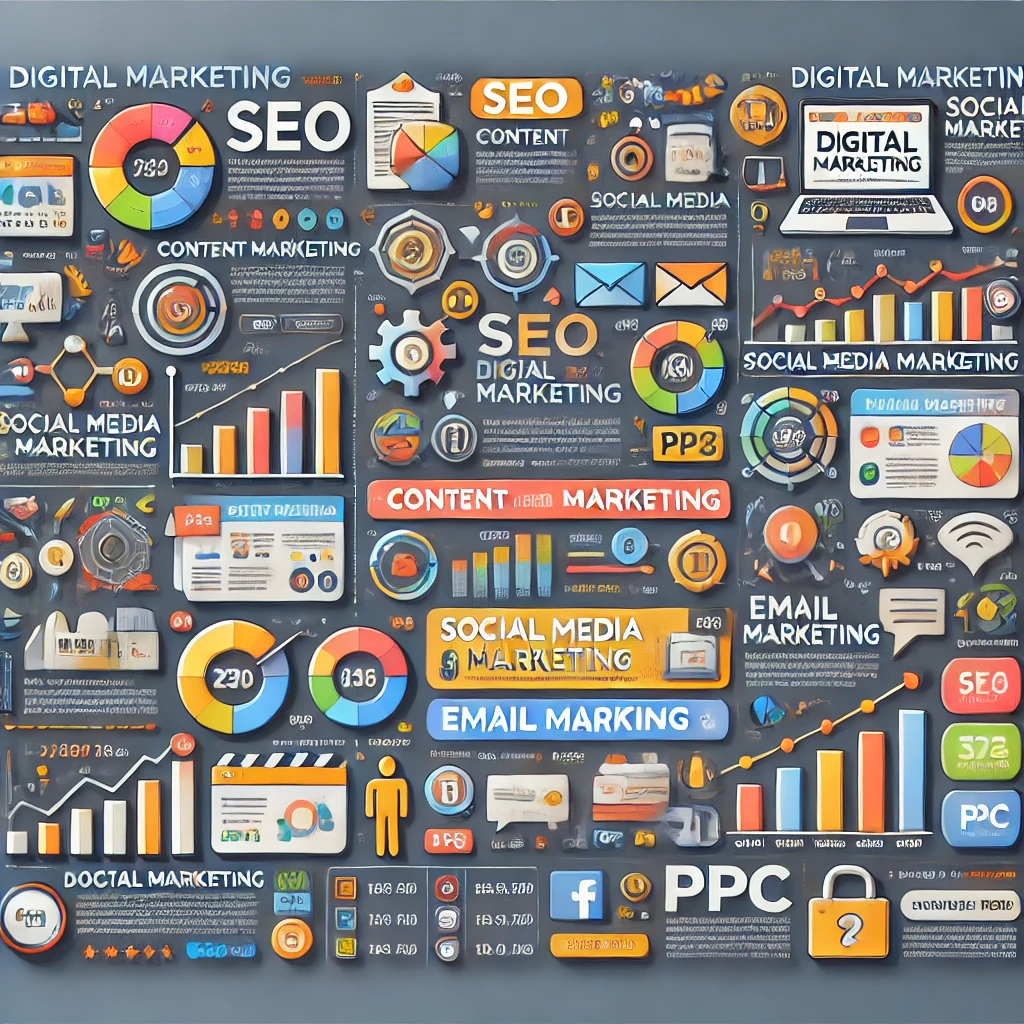Table of Contents
ToggleWhat is Digital Marketing?
In today’s fast-paced digital world, businesses must leverage online platforms to reach and engage their target audience. Digital marketing has become an essential strategy for companies of all sizes to promote their products and services effectively. But what exactly is digital marketing, and how can it benefit your business? This guide will provide an in-depth understanding of digital marketing, its various components, and how you can implement it successfully.
Understanding Digital Marketing
Digital marketing refers to the use of digital channels, such as websites, search engines, social media, email, and mobile apps, to promote brands, products, and services. Unlike traditional marketing methods, digital marketing enables businesses to connect with their audience in real time, measure performance, and optimize campaigns for better results.
Key Components of Digital Marketing
Digital marketing encompasses several strategies and techniques, each designed to reach potential customers in different ways. Here are the key components:
1. Search Engine Optimization (SEO)
SEO is the process of optimizing your website to rank higher on search engines like Google and Bing. By using relevant keywords, creating high-quality content, and improving site speed, businesses can attract organic traffic and increase visibility.
2. Content Marketing
Content marketing focuses on creating valuable, informative, and engaging content to attract and retain customers. This includes blog posts, articles, videos, infographics, and eBooks that educate and inform your audience.
3. Social Media Marketing
Social media platforms like Facebook, Instagram, Twitter, LinkedIn, and TikTok allow businesses to connect with their audience, share content, and run paid advertising campaigns. Social media marketing helps in building brand awareness and engaging customers in meaningful conversations.
4. Pay-Per-Click Advertising (PPC)
PPC is a paid advertising model where businesses pay a fee each time someone clicks on their ad. Google Ads and Facebook Ads are popular PPC platforms that allow businesses to target specific demographics and maximize ROI.
5. Email Marketing
Email marketing involves sending personalized messages to a targeted audience to promote products, services, or special offers. It is an effective way to nurture leads, retain customers, and drive sales.
6. Affiliate Marketing
Affiliate marketing is a performance-based strategy where businesses collaborate with influencers or affiliates to promote their products. Affiliates earn a commission for each sale generated through their referral links.
7. Influencer Marketing
Influencer marketing leverages the popularity of social media influencers to promote products or services. By partnering with influencers, businesses can reach a larger audience and build credibility.
8. Mobile Marketing
With the increasing use of smartphones, mobile marketing has become a crucial aspect of digital marketing. This includes SMS marketing, mobile apps, and mobile-friendly websites to reach users on their devices.
9. Video Marketing
Video content has gained immense popularity in recent years. Platforms like YouTube, TikTok, and Instagram Reels provide opportunities for businesses to engage their audience through compelling video content.
10. Marketing Analytics & Data Analysis
Analyzing data is essential for optimizing digital marketing strategies. Tools like Google Analytics, SEMrush, and HubSpot help businesses track user behavior, measure campaign performance, and make data-driven decisions.
Benefits of Digital Marketing
- Global Reach – Digital marketing allows businesses to reach a worldwide audience without geographical limitations.
- Cost-Effective – Compared to traditional advertising methods, digital marketing is more affordable and offers a higher return on investment (ROI).
- Targeted Advertising – Businesses can tailor their marketing campaigns to specific demographics, interests, and behaviors.
- Measurable Results – Digital marketing provides detailed analytics to track performance and optimize campaigns for better outcomes.
- Enhanced Engagement – Through social media, email, and interactive content, businesses can engage with customers in real time.
- Improved Conversion Rates – Digital marketing techniques, such as retargeting ads and email campaigns, help convert leads into customers.
How to Get Started with Digital Marketing
If you are new to digital marketing, follow these steps to build a successful strategy:
- Define Your Goals – Identify your marketing objectives, such as brand awareness, lead generation, or sales growth.
- Know Your Audience – Research your target audience’s demographics, preferences, and online behavior.
- Choose the Right Channels – Select the most suitable digital marketing channels based on your audience and business type.
- Create High-Quality Content – Develop engaging and informative content that adds value to your audience.
- Optimize for SEO – Use relevant keywords, meta descriptions, and backlinks to improve search engine rankings.
- Leverage Social Media – Actively engage with your audience through social media platforms and share valuable content.
- Invest in Paid Advertising – Run targeted PPC campaigns to drive traffic and conversions.
- Analyze and Optimize – Continuously monitor performance metrics and refine your strategy for better results.
Conclusion
Digital marketing is a powerful tool that enables businesses to connect with their audience, enhance brand visibility, and drive sales. By leveraging various digital marketing techniques, companies can create effective campaigns, measure success, and continuously improve their strategies. Whether you’re a small business or a large corporation, digital marketing offers endless opportunities to grow and succeed in the digital landscape.
Start implementing digital marketing today and watch your business thrive in the online world!



